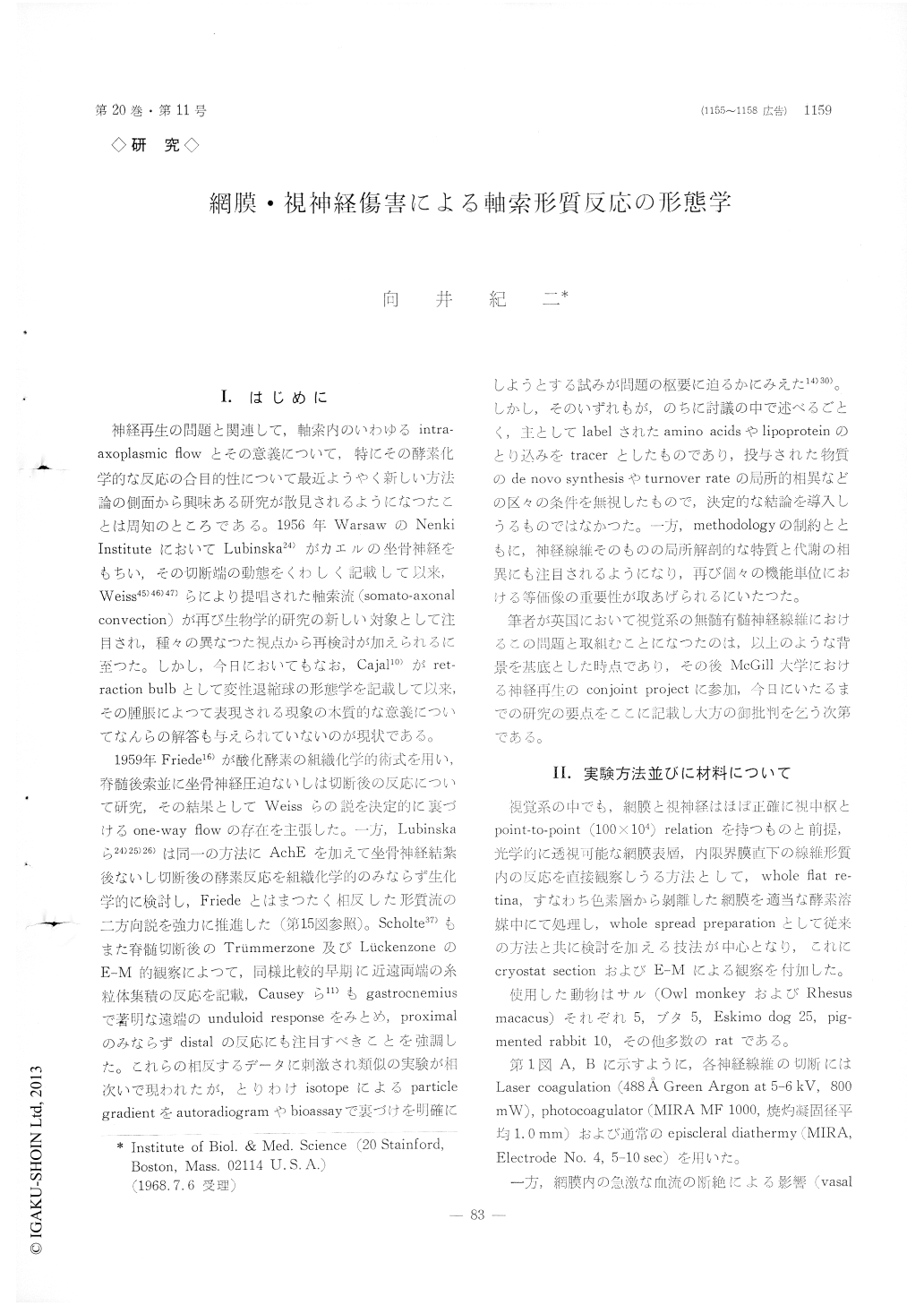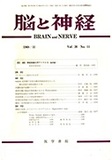Japanese
English
- 有料閲覧
- Abstract 文献概要
- 1ページ目 Look Inside
I.はじめに
神経再生の問題と関連して,軸索内のいわゆるintra—axoplasmic flowとその意義について,特にその酵素化学的な反応の合目的性について最近ようやく新しい方法論の側面から興味ある研究が散見されるようになつたことは周知のところである。1956年WarsawのNenki InstituteにおいてLubinskaL4)がカエルの坐骨神経をもちい,その切断端の動態をくわしく記載して以来,Weiss45)46)47) らにより提唱された軸索流(somato-axonalconvection)が再び生物学的研究の新しい対象として注目され,種々の異なつた視点から再検討が加えられるに至つた。しかし,今日においてもなお,Cajal3)がret—raction bulbとして変性退縮球の形態学を記載して以来,その腫脹によって表現される現象の本質的な意義についてなんらの解答も与えられていないのが現状である。
1959年Friedei6)が酸化酵素の組織化学的術式を用い,脊髄後索並に坐骨神経圧迫ないしは切断後の反応について研究,その結果としてWeissらの説を決定的に裏づけるone-way flowの存在を主張した。一方,Lubillskaら24)25)26) は同一の方法にAchEを加えて坐骨神経結紮後ないし切断後の酵素反応を組織化学的のみならず生化学的に検討し,Friedeとはまったく相反した形質流の二方向説を強力に推進した(第15図参照)。Scholte37)もまた脊髄切断後のTrummerzolle及びLtickenzoneのE-M的観察によって,同様比較的早期に近遠両端の糸粒体集積の反応を記載,Causeyら11)もgastrocnemius.で著明な遠端のunduloid resPonseをみとめ,proximalのみならずdistalの反応にも注目すべきことを強調した。これらの相反するデータに刺激され類似の実験が相次いで現われたが,とりわけisotopeによるparticle gradientをautoradiogramやbioassayで裏づけを明確にしようとする試みが問題の枢要に迫るかにみえた14)30)。しかし,そのいずれもが,のちに討議の中で述べるごとく,主としてlabelされたamino acidsやlipoproteinのとり込みをtracerとしたものであり,投与された物質のde novo svllthesisやturnover rateの局所的相異などの区々の条件を無視したもので,決定的な結論を導入しうるものではなかつた。一方,methodologyの制約とともに,神経線維そのものの局所解剖的な特質と代謝の棚異にも注目されるようになり,再び個々の機能単位における等価像の重要性が取あげられるにいたつた。
Since Weiss et al. provided a new theory concerning intraaxonal, somato-axoplasmic convection, nerve fibers have been proposed as channels whereby substances can flow distally clown its growth cone. In 1959, Friede showed that a constriction around a nerve trunk caused a swelling of nerve axons proximal to the constriction, which he interpreted as the accumulation of core material produced by the neuronal soma and moving down the axonal segments. However, Lubinska reported divergent results which were viewed as evidence of both downward and upward movement by means of bio-chemical and histcchemical perusals. Because of these discrepancies it was felt that a similar study, performed on non-myelinated sensory nerve fibers, and especially on the visual system, would be of interest. As the retina has the highest rate of res-piration of any tissue in the body, it has a unique enzyme map. It is presumed that because of this, it may respond to trauma in a complex fashion, quite different from the oridinary reaction of re-generation and degeneration.
Preliminary experiments done by the author have demonstrated the existence of an intensive enzymatic damming detectable in flat whole mount spreading preparations treated with the substrate of NADH2 tetrazolium oxidoreductase. The terminal axoplasmic enlargements were mainly mitochondria ; peculiar myeloid concentric lamellar bodies with intermingl-ing lipid granules were identified as metamorphous lysocytosomes and some characteristic macromolecular particles derived from a derangement of membrane-ous system. However, the fine structure of these enzymatic changes was not exhaustively studied.
The study of the response of the retinal nerve fibers to injury by sectioning, diathermy electrode, photocoagulation, and laser burn has been discussed in this paper. The animals were sacrificed at in-tervals varying between 1 and 120 hours after surgical treatments and the regenerative and regressive pro-cesses in the nerve fibers have been investigated by cytochemical and electron microscopic procedures. The results indicated that in the optic system there is a definite preponderance in centrifugal direction? heaping-up enzymes mainly at the distal segments rather than the transperikaryon conveyance. Aim of the present study is to clarify the possible me-chanism on axoplasmic regrowth of the retina and optic nerve fibers. A preponderance of enzyme activities of NAD-linked dehydrogenases, Glucose-6-P, PAS glycogen, acid-P and GSH suggests that the reparatory mechanism may be implicated by different channels in terms of metabolic pathways. This is particularly true in the aerobic glycolysis which must be one of the most important sine qua non condition in retaining the axoplasmic regrowth. In this respect, nerve growth prompting factor (NFG) is also being considered in relation to certain poly-peptides of the axonal protein. If it is possible to make a device to retain an appropriate milieu pre-venting the progressive disruption of mitochondrial membrane, one would a priori assume there should be more subtle ways for the metabolic reorientation. Perhaps the maintainance of axoplasmic molecules would mainly be directed by messenger-RNA derived from the perikarya, it is conceivable that they just make an erroneous orientation sometimes ; to assume that this is the way the axoplasm is using for breaking-down organelles and reutilizing them seems rather crude from a physiological standpoint. A biochemi-cal interest has been centered around the elucidation of reactivating substrate of the fiber regrowth, the phenomenon which has long been presumed as "abortive or ephemeral regenerative response." The latest theory of the intra-axonal autochthoneous synthesis of protein described by Koenig has made another impact, although it leaves quite amounts of puzzlement behind it. A review of the literature on the points brings out a welter of contradictions and emphasizes the state of confusion which reigns because of conclusions drawn on a monophasic phe-nomenon without employing reliable methodology directly applicable to its delineation. On the other hand, there is reasonably tight evidence by means of isotope tagged amino-acid in analyzing the delayed incorporation, such evidence is still wanting as an explanation of the metabolic macromolecules from the perikaryon to the severed segment. It is hoped that the information accumulated by these techni-ques will improve our understanding of the intra-axoplasmic streaming. Questions to be answered by this research are : does the directional response mean a directional streaming of the axoplasm ; and does the retrograde retispersion chromatolysis of the endoplasmic reticula mean an outflow of the mole-cular components from perikarya into the damaged axonal endings?
To the author's knowledge this type of research has never been performed on the retinal neuronal soma. It is hoped that the proposed investigation will improve our knowledge of the retinal enzyme map, which is unique in the body. At the same time it may yield information of more general value on the repair processes of nonmyelinated sensory nerve fibers.

Copyright © 1968, Igaku-Shoin Ltd. All rights reserved.


